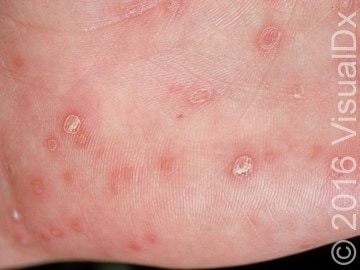Published on
Differential Diagnosis
- Alopecia areata
- Pityriasis rosea
- Reactive arthritis
- Secondary syphilis

Diagnosis
This patient was diagnosed with secondary syphilis, the second stage of the infection caused by spirochete, which has spread throughout the entire body. Typically, it occurs 1–3 months after the appearance of the primary syphilitic chancre.
Learnings
- Secondary syphilis is characterized by hematogenous and lymphatic dissemination
- Patchy alopecia is distinctive of secondary syphilis
- Other symptoms could include weight loss and lymphadenopathy
- Malignant syphilis, or lues maligna, is a rare, noduloulcerative manifestation of secondary syphilis. Most contemporary cases have been reported in the setting of underlying human immunodeficiency virus infection
Pearls for Urgent Care Management and Considerations for Transfer
- The lesions of secondary syphilis heal in 2–10 weeks, with or without treatment If left untreated, up to 25% of patients will relapse within the first 2 years
- Ocular screening (eg, slit lamp examination) is advised for patients with suspected or proven syphilis
Acknowledgment: Images courtesy of VisualDx.
A 28-Year-Old Man Complaining of Tiredness, Myalgia, and Sore Throat
1 2
